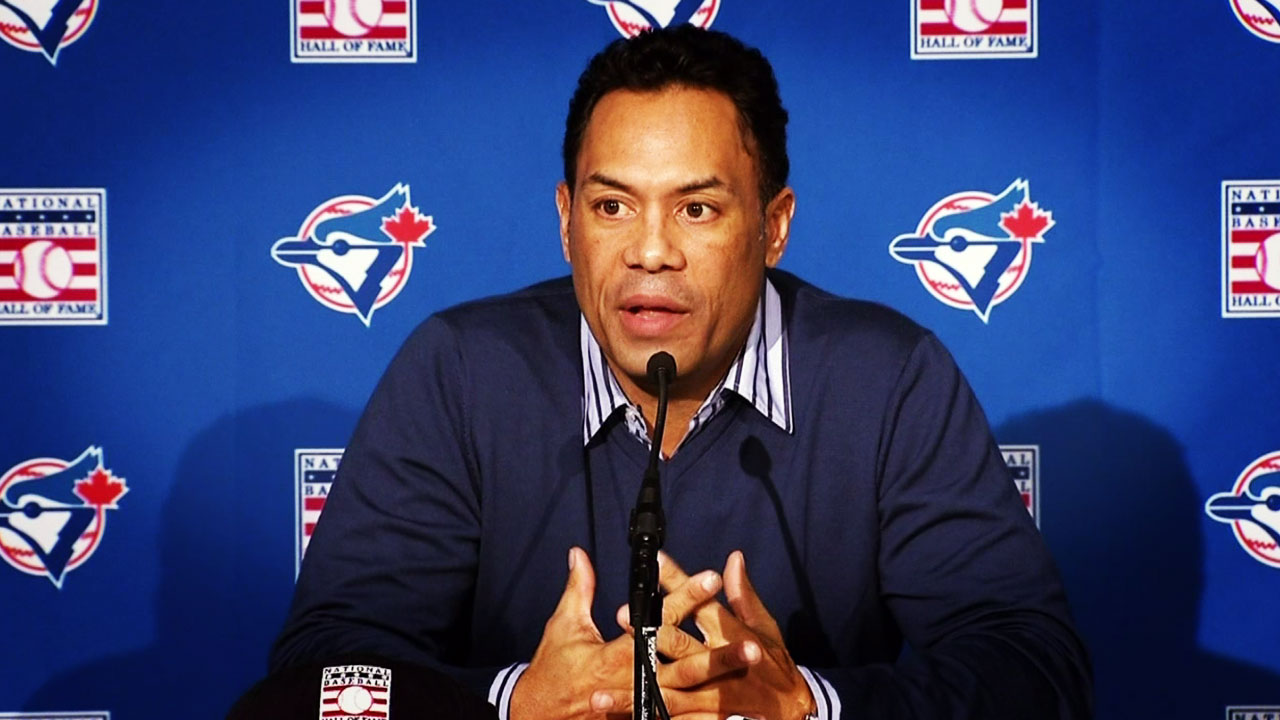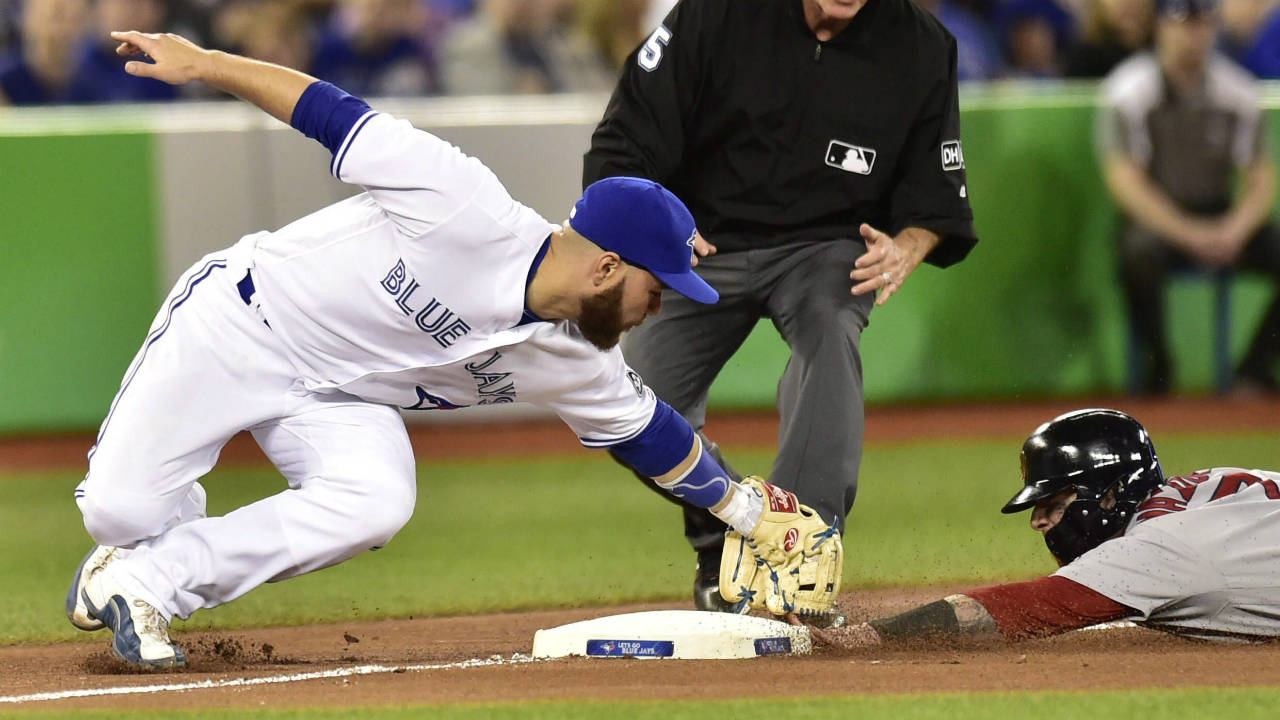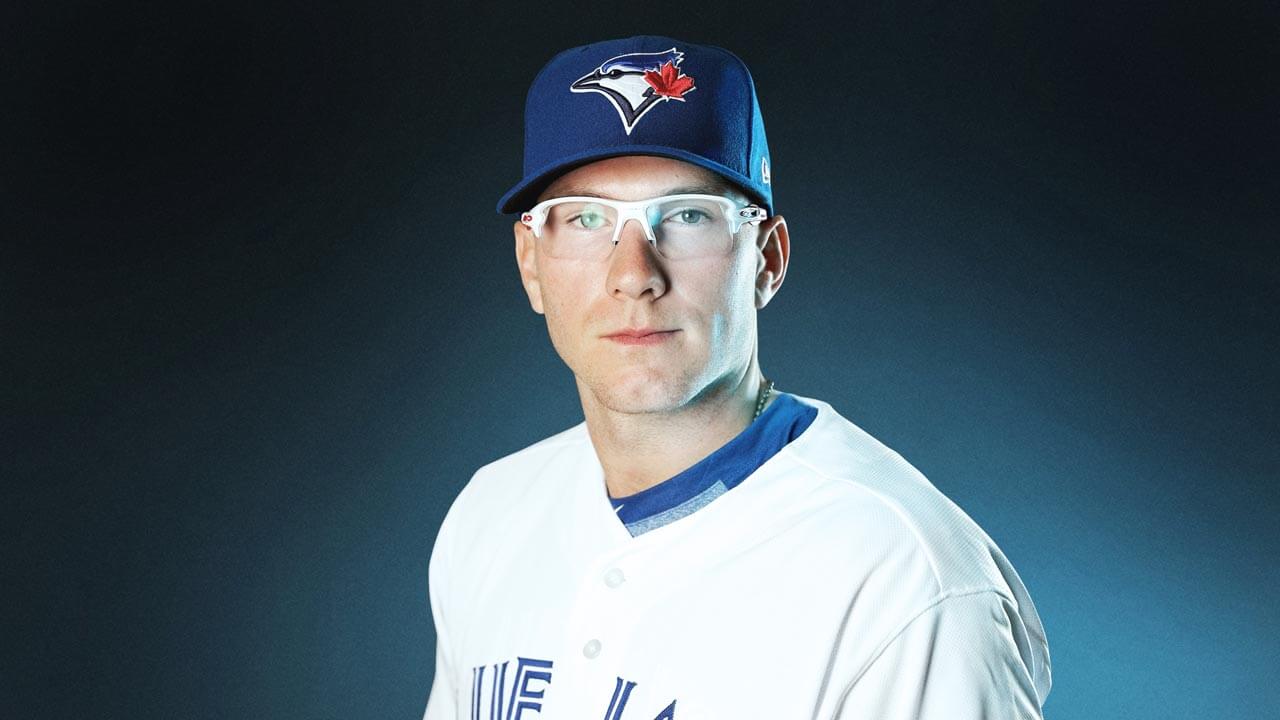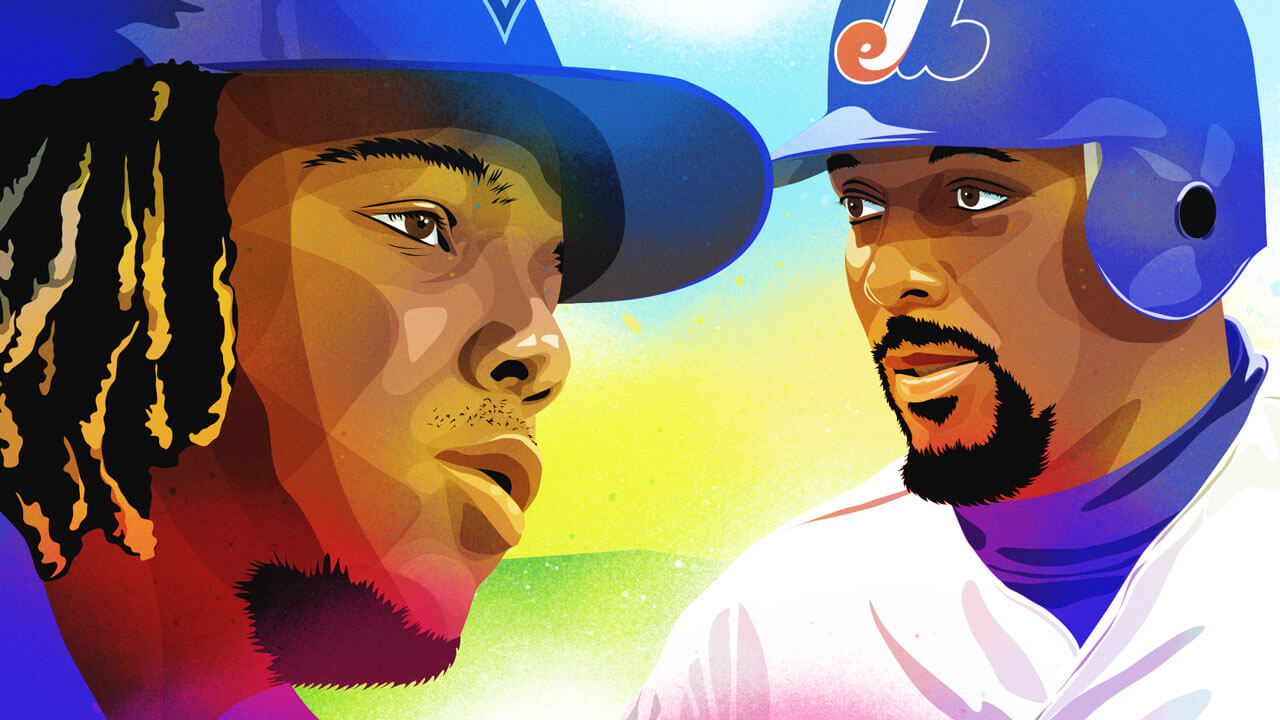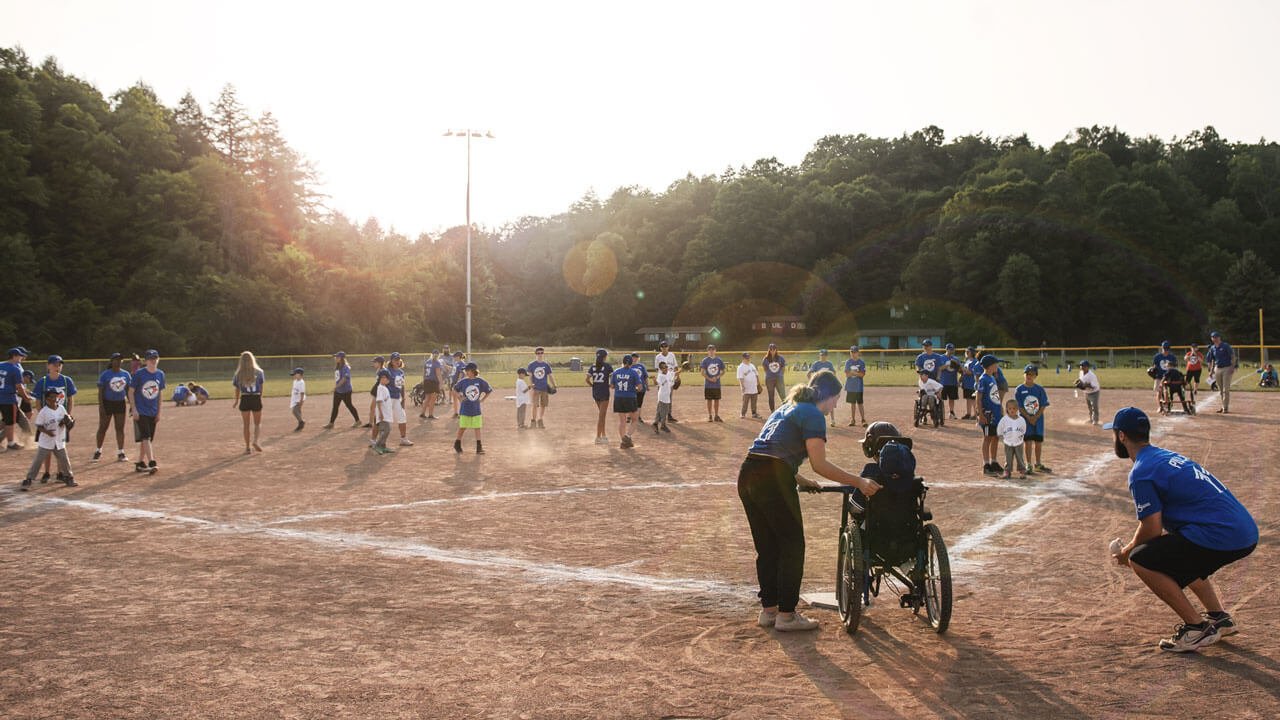It’s almost a scene out of a high-school dance. There are 150 teenage boys gathered in the lobby of a hotel located in the heart of San Juan, Puerto Rico. Some are clustered in small groups, chatting and sipping bottled water or coffee. Others sit by themselves, scrolling on their phones or savouring pastries from the lobby café. There’s a bubbling excitement in the air, but not much in the way of mingling. Each boy is dressed to the nines. There are no suits — it’s 5 p.m. and still way too hot and humid for a jacket — but polo shirts and V-necks are accompanied by crisp jeans and dress shoes or fresh-out-of-the-box sneakers. When you’re going to an event hosted by Hall of Fame second baseman Roberto Alomar, you better look like you belong.
Transportation arrives and the boys pack onto a row of yellow school buses. One of the drivers has outfitted his ride with massive speakers and is playing reggaeton off his iPhone. The song “Hipócrita” by Puerto Rico’s own Anuel AA is blaring and helps unite the youth on this particular bus. When the driver receives a call that cuts off the music, it evokes collective boos from his passengers. Following a 20-minute ride through the capital, the bus arrives at Centro Para Puerto Rico, home to a private, non-partisan organization with a mission statement that includes reducing poverty and inequality on the island while strengthening ethical values and social responsibility. Inside, Alomar is waiting, just back from Induction Weekend at the Baseball Hall of Fame. This is the opening ceremony of his inaugural PR12 Baseball Showcase Tournament and the 50-year-old is all smiles.
The boys, who over the next week will play in front of pro and college scouts during a competition that could drastically alter their lives, take their seats in the building’s foyer and are served arroz con pollo with soda. Posters with the red, white and blue PR12 branding flank a large, elevated stage in front of them. There’s an opening address and then Alomar is handed the microphone. “My message will be very short but precise,” he begins.
“My mom and dad used to tell me that there was a tunnel that I had to walk directly until the end,” Alomar says in Spanish. “At the end of it, I would find my dreams achieved. But I would only make it if I followed the right path. There were doors on that tunnel. Doors filled with temptations like parties, girls — everything — but I stayed on the right path because that was the advice my parents gave me. At the end, I got there. I achieved my dream of being part of the MLB. That was my dream.
“I already played,” he continues. “This tournament is not for me, it’s not for the coaches. This tournament is for all of you. It’s an opportunity we are giving to the youth of Puerto Rico, so they can showcase their talent.” When he’s done speaking, Alomar leaves the stage to enthusiastic applause.
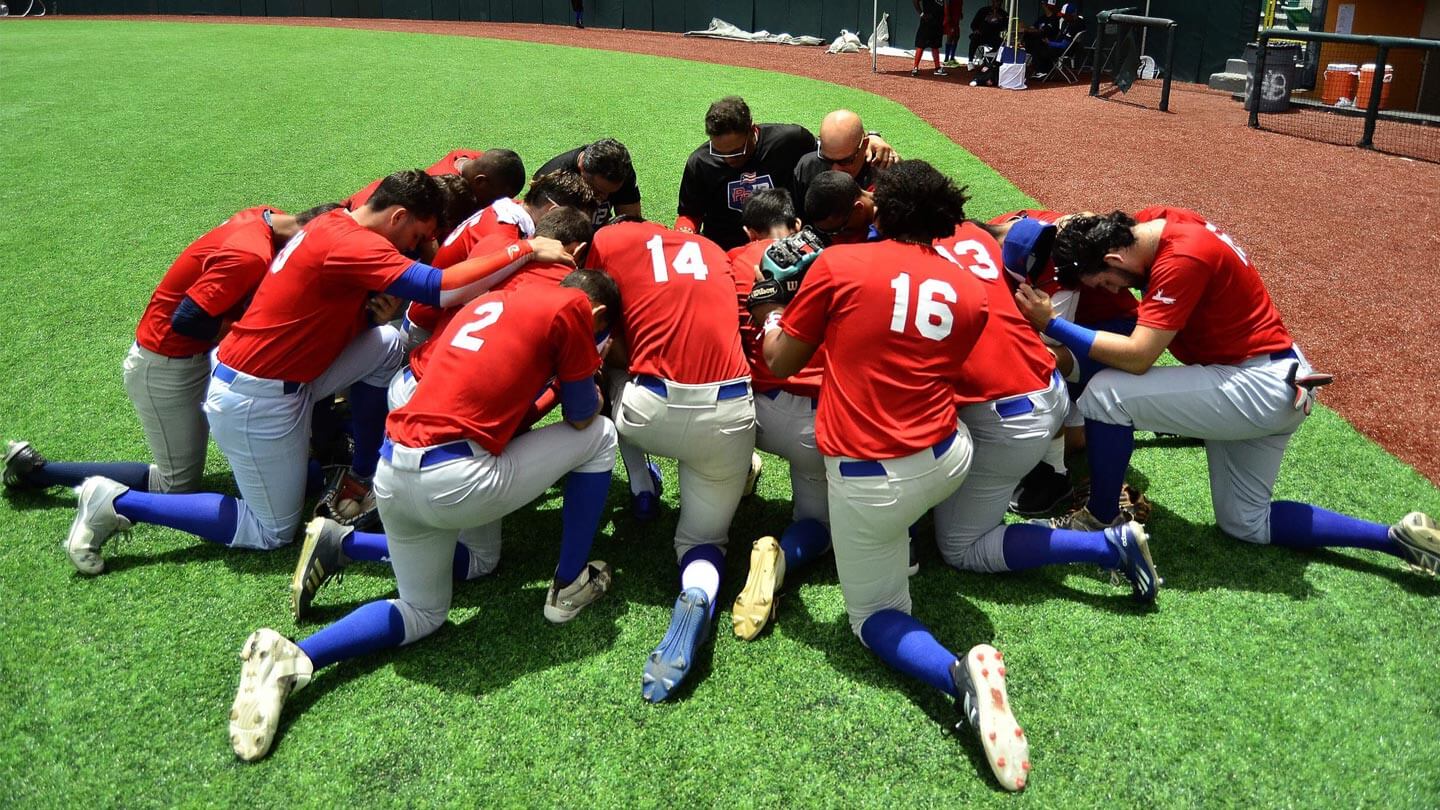
The passageway he illustrated led him to many accolades. Alomar captured two World Series titles with the Toronto Blue Jays, and collected 10 Gold Gloves and 12 all-star appearances en route to becoming arguably the best ever at his position. The focus, discipline and determination he showed during his 17-year big-league career paid off with a plaque in Cooperstown. And now, with his playing days long over, the Puerto Rican native is channeling those same traits toward the goal of elevating baseball in his home nation.
Tonight, though, is for the youth and once the speeches wrap up, a concert breaks out. A trumpet player, two drummers and an emcee emerge wearing turquoise-rimmed shades, black dress shirts and ties dotted with flashing Christmas lights. They perform batucada, a fast-paced offshoot of samba music that’s popular in Puerto Rico during special occasions, such as high-school proms. With the music pulsating to near-deafening levels, the emcee leads the crowd in a call-and-response, imploring them to raise their hands and sway left then right. A conga line forms as the teenage baseball players snake their way throughout the lobby. Not a drop of alcohol is served, of course, but they look drunk off happiness.
Alomar stands far from the centre of the action, near the back left-hand side of the stage. His face is still lit by that smile. As the celebration unfolds, he sneaks out the front entrance unannounced, letting the kids enjoy their moment. This is for them, after all, and besides, he’s got plenty of work to do.
The seeds of the PR12 tournament were sown in Toronto back in 2013. Alomar, who was already heavily involved in amateur baseball through clinics and camps, was approached by the Blue Jays to lead a new initiative — a showcase that would serve as a centralized event for the best young players in Canada, putting them all in one place and offering exposure to pro and college scouts.
That tournament was named T12, incorporating the number Alomar famously wore during his major-league career, and it was an instant success. Once Alomar witnessed its potential, he set out on a mission to bring something similar to Puerto Rico and offer the same opportunities to youth on the island. “I was one of them once,” he says. “I was able to sign professionally, but I know how tough it is for a lot of the kids to be seen by scouts.”
Baseball in Puerto Rico shares that difficulty with its Canadian counterpart: it can be hard for even promising players to get noticed. Remote parts of the island are not easily accessible and travel eats up valuable time, so there can be a reluctance among talent evaluators to visit certain areas unless they are dead-certain a top-end prospect will be waiting. In addition, Puerto Rico has been included in the MLB Draft since 1989; this means that instead of signing as amateur free agents — like Alomar did in 1985 with the Padres, and like players from fellow Caribbean nations Venezuela and the Dominican Republic do today — Puerto Rican high-schoolers are subject to the same rules as those on the U.S. mainland, where resources are much more plentiful and development programs are much stronger. “We get compared to the people in the United States,” says Carlos Baerga, former all-star second baseman with the Indians and a close friend of Alomar’s. “Over there you have high schools that look like universities and colleges. You play, over there, four times a week; here you play one time a week, on Saturday. And we practice maybe once or twice. That’s the big advantage players in the States have over us.”
American players also tend to have stark financial advantages. According to 2016 U.S. Census Bureau data, Puerto Rico’s 43.5-per cent poverty rate was more than double that of the poorest U.S. state. Some youth baseball players on the island have had no exposure to the wider world outside their own villages, with money for travel or accommodations not even a possibility for them.
The combination of all these factors appears to be impacting the nation’s representation in MLB. In 2002, there were 39 players born in Puerto Rico on Opening Day rosters; that number shrunk to just 11 in 2012 before climbing back up to 19 this season.
[snippet id=3966765]
With that as both backdrop and motivation, Alomar had been trying for years to secure sponsors to help expand T12 to Puerto Rico. In the fall of 2016, he met with MLB commissioner Rob Manfred and deputy commissioner Dan Halem and was so convincing the league almost immediately came on board. “His personal passion for the project convinced us to partner with him,” Halem says. “And the fact that he did this in Canada first and it was a success certainly made it quite logical to export it to Puerto Rico. His passion for helping and giving back to the people of Puerto Rico is so great that, literally, after the first or second meeting, the commissioner told me, ‘We need to officially make him our ambassador.’”
Alomar was named MLB’s special consultant in Puerto Rico in March 2017, officially setting the wheels for PR12 in motion. Over the next year, he was like a man possessed, according to those around him. He was in constant contact with Halem and Co. and frequently dropped by the league’s headquarters in New York to provide updates. PR12 tryouts were held in different regions of the island from April to June and Alomar was there for each one, ultimately helping whittle 500 prospective participants down to the final 150. Friends say he is putting some of his own money into the tournament and that he even occasionally arrived in Puerto Rico to help out and then flew off to another commitment later the same day. “He has everything, he’s in the Hall of Fame, I don’t know why he is here,” says Ulises Rosario, PR12’s head trainer. “He has passion for the baseball player in Puerto Rico. He’s working with them because he wants to give back what he has received in the game. He’s trying to pay forward what he got. He’s too humble. Now, he can go anywhere in the world and spend his time doing whatever he wants, but he’s here every month.”
Adds Baerga: “Robbie is getting into this very, very, very, deep.”
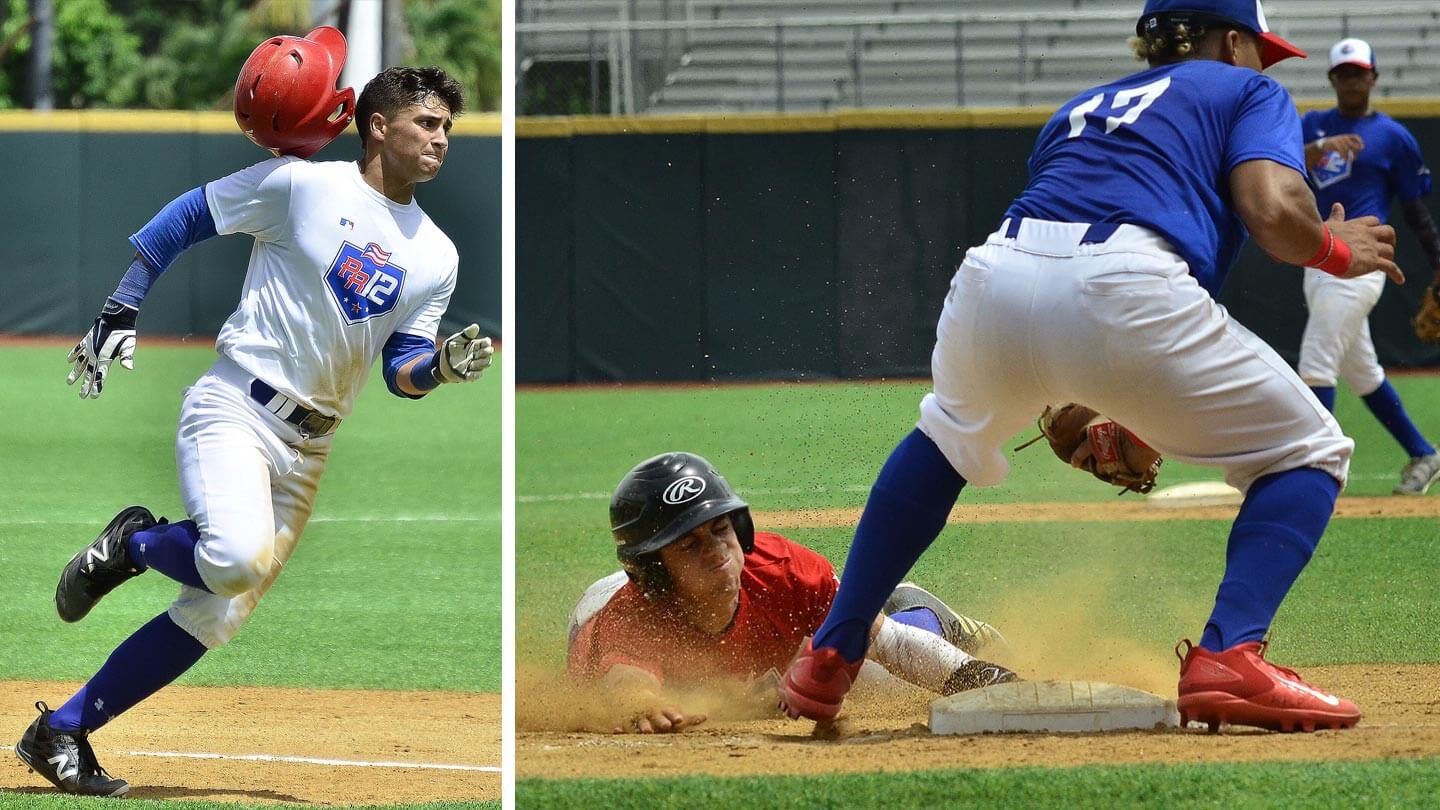
Estadio Hiram Bithorn is the nerve centre of baseball on this island. Opened in 1963 and named after the first Puerto Rican player to reach the majors, in recent years the San Juan stadium has played host to three World Baseball Classics and several MLB games. The Blue Jays opened the 2001 regular season here; the Expos called it home for a portion of their schedule in 2003 and ’04; and earlier this year, the Indians and Twins showed up for a two-game series.
Inside the ballpark, a spectator’s senses are immediately greeted with a burst of colour. The majority of seats are bright orange, but the left- and right-field stands change hue as they get closer to the outfield fence, shifting to lime green, pink, grey and light blue. It’s not a quiet venue, either. The drone of planes arriving and departing from the nearby airport is a constant, with some passenger flights passing so low you can spot airline logos. The crack of the bat here is more emphatic, too, reverberating off the large, wave-shaped facade that covers much of the stands.
Hiram Bithorn was fundamental to Alomar’s childhood, when he would gambol in the clubhouse while his father played for the pro club Cangrejeros de Santurce. Former teammates of Sandy Alomar Sr. — who also enjoyed a 15-year MLB career — remember a young Robbie swiping their gloves and taking the field before games. Years later, Alomar figured that no other venue would suffice for PR12, so he worked with the mayor of San Juan to bring his tournament here. “It is important to try to give the kids a taste of what it’s like to play almost on a big-league field,” he says. “To get to a place where they can feel comfortable doing it.”
The first day on the showcase schedule is a scout day, where players run through a combine in front of a bevy of MLB and college evaluators. The first group arrives at the park around 8 a.m. They file into the brightly lit home clubhouse and begin to get dressed; some attentively slip on their blue socks, making sure the fold is just right, while others tape their wrists or lace up cleats. A coach cracks a joke, perhaps hoping to dispel a bit of the nervousness in the room, and it’s met with just a few laughs. The solemnity wavers a few minutes later, though, when each player is handed a PR12 hat. With a blue body, red brim, white crown and the MLB logo stitched on the back, it’s just like the big leagues and strikingly similar to the one Alomar donned during the Blue Jays’ glory days.
The combine consists of a 60-yard dash, outfield throws, infield grounders, catcher tosses and batting practice. Early anxiety is evident — a shortstop sails consecutive bullets over the head of the first baseman, while an outfielder fires wide of home plate and nearly into a group of onlookers hugging the first-base line. The nerves are certainly understandable — this is the last real shot at being seen for some of these teens — but the tension eventually does give way to superior talent. At one point, a major-league scouting director stops talking entirely in mid-conversation, mesmerized by the hacks a few youngsters are taking in the batter’s box, his jaw literally dropping as the sound of contact snatches his attention. By 11 a.m. it’s safe to say there’s a consensus among the observers: It was well worth the trip to see the talent assembled here today.
Ritch Price, head baseball coach at the University of Kansas, acknowledges as much. While most of the players on his team are from out of state, none are Puerto Rican. He wants to change that and is here looking specifically for a shortstop. “Because it’s an American territory, you’re more apt to find a young man who meets the NCAA qualifications than if they were coming out of the Dominican Republic,” Price says. “This is a great starting point. To walk in here and have Roberto Alomar’s name associated with this event, right away gives it credibility … This tournament could open up doors for a lot of kids who wouldn’t get an opportunity [otherwise].”
Price notes that a contingent of Puerto Rican players is usually present at an annual showcase in Florida run by Perfect Game USA, an American scouting service. However, costs associated with travel and participation in that event can pose insurmountable barriers to entry for some youth from the island. On the other hand, PR12 is completely free to players, their travel, food and hotel are covered. Alomar was adamant about making that a reality, and hopes his tournament can lead to more educational opportunities for Puerto Rican high-school players. The hard truth in baseball is that not every prospect will reach the majors and having a fallback is crucial. “What I’m trying to do with this tournament is to help give them a good life,” Alomar says of the players. “Hopefully to start in the right direction and give them an opportunity to go to college and get a scholarship. Maybe they can find a way where they can make a good living after baseball with a degree. Or be a doctor, lawyer, or whatever profession they want to take. It’s just hopefully going to open doors for the right direction in their life.”
To Alomar, providing that start seems to require getting involved with even the minutiae during scout day. In one instance, he helps a group of coaches push the batting cage forward; later, he offers a pep talk to infielders gathered to the left of second base. Wearing the same hat as the kids, a black PR12 shirt and shorts, Alomar is on his feet all day under the intense sun. It’s 30 degrees Celsius, even before the humidity, yet as each wave advances through the drills, he refuses to retreat to the shade of the dugout like some of the other coaches have. When asked if he’s hot, he replies, “I’m good,” with a smile, his face gleaming with sweat. “I’m used to this. Where I’m from, it’s hotter. You can ask my dad. Salinas is closer to the sun.”
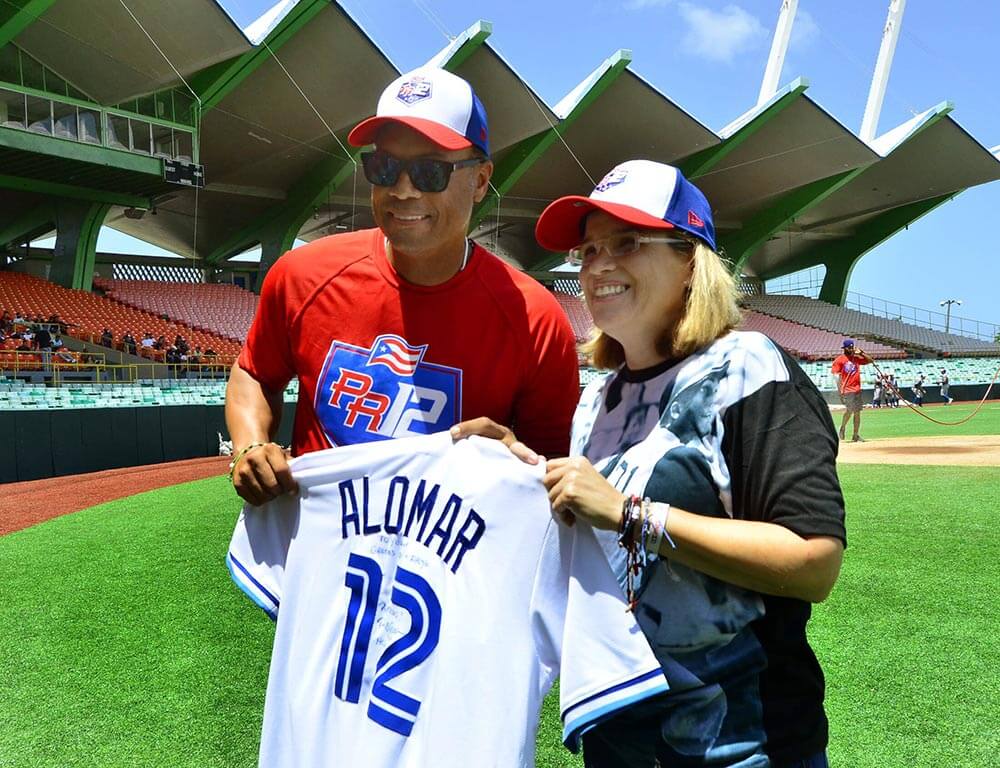
Flying into Puerto Rico, you get an overhead view of the island, one that offers the sight of neighbourhoods dotted with blue. At first glance, it looks almost intentional and even beautiful, like the Greek island of Santorini or the Indian city of Jodhpur; that couldn’t be further from the case, though. Each tiny blue rectangle is one of the plastic tarps provided by the U.S. Federal Emergency Management Agency (FEMA) for residents to use as temporary roofs — a reminder of the destruction that Hurricane Maria brought to the island almost one year ago.
Salinas, hometown of the Alomar clan, didn’t escape the Category 5 storm that made landfall on Sept. 20, 2017. Sandy Sr., the 74-year-old patriarch of the family, was at home with his wife, Maria, his brother and his granddaughter — Alomar’s niece — and recalls holding one of the doors closed while the others pressed mats against the walls to prevent water from seeping through. “I was glad that I was here so I could help our family,” he says. “It was the longest storm I have ever endured on the island. It was devastating.”
Hurricane Maria was one of the most vicious natural disasters in modern U.S. history, and left a major humanitarian crisis in its wake. The death toll has been estimated in the thousands and the storm wrought an estimated $90 billion in damages. With the power grid and other key infrastructure ravaged, a large majority of the island’s 3.4 million people were left without electricity or stable means of communication for months. Sandy Sr. had stocked up on food and water, while Baerga, who’s a special adviser for the Indians, helped the Alomar family secure a generator, which at the time was a sought-after commodity. Cellular coverage was another story, and the elder Alomar was unable to contact his sons Roberto and Sandy Jr. — a coach with the Indians — in North America. “You just sit and wait,” recalls Roberto. “Afraid, scared … It was struggles, but you just have to sit and wait and pray every day that hopefully your family and friends are good. And then, when you get the phone call, you breathe a little bit.”
A family friend managed to connect with Alomar a few weeks after the storm to let him know his family was safe. As soon as the airport re-opened, he flew home on a private plane. “Devastation — that’s all I saw,” he says. “Driving through the freeways, there were no trees, all blank. Trees on the floor, houses down. Streets were blocked, so you had to take different routes. Devastation.”
“Baseball players were among the first ones to come to Puerto Rico and help after the hurricane,” says Carmen Yulin Cruz, mayor of San Juan. “When the federal agencies were saying they couldn’t land planes, the Astros and Twins, and Roberto Alomar, and Jorge Posada and his wife were bringing private planes to bring food, water and medicine to Puerto Rico.
“But more than that, they brought pride and hope,” she continues. “In a time when you have been really beaten hard by a hurricane and then not treated properly by the federal government — and I’m being very soft about that — they brought smiles to people’s faces. Alomar was one of those. Nobody had to ask him, or any of these players, for help.”
[snippet id=3918627]
Cruz notes that most of Puerto Rico has now regained power, but the island is not ready should another hurricane hit. She became a key voice of the territory in the aftermath of Maria, speaking out against President Donald Trump’s administration and its response to the disaster and famously proclaiming during an appearance on CNN, “Dammit, this is not a good news story, this is a people-are-dying story.” FEMA administrator Brock Long responded to her criticisms by saying the mayor had been “filtered out” as political noise by the organization.
The official death count was listed at 64, but a recent study from the New England Journal of Medicine estimates that 4,645 people lost their lives as a result of the hurricane. “I waved a red flag that we were dying,” says Cruz. “That if the help didn’t get into the right hands, we were going to die in great numbers. Unfortunately, I was right.”
FEMA later admitted that it wasn’t prepared to properly respond to the disaster and underestimated how much food and fresh water were needed. “The American government were finding excuses not to help us. They would say, ‘Oh the logistics are unsurmountable,’” Cruz says. “Yeah, you can put a guy on the moon 238,000 miles from here but you can’t bring water 1,000 miles from the U.S. coast?”
Nicole Fraticelli is general office manager at Chocobar Cortés, a restaurant in the tourist section of Old San Juan. Chocobar wasn’t hit as hard as other establishments in the area and, thanks to a sturdy power generator, it quickly became a communal hub. In the immediate days following Maria, it sold whatever was left in the fridge for low prices and became one of the few places in the vicinity where local residents and first responders could find a hot meal or coffee. The shop specializes in chocolate and desserts, yet began serving rice and beans to help sustain people.
The entire experience reinforced something to Fraticelli. “People here have been resilient,” she says. “[And] a lot of people maybe learned a lesson in that aspect: that they can’t count on anyone but themselves. Puerto Rican people have their communities and it’s a big resource. If you have your community together and your people together, your family, then you can do just about anything.”
Baerga’s relationship with Alomar dates back three decades. The second basemen first met in spring training in 1986, when they were both in the Padres organization, and quickly developed a bond, even rooming together for some time. Today, their friendship is ironclad. The two have travelled the baseball world together post retirement, holding clinics in Canada, Colombia, Panama, Venezuela and the Dominican Republic, among other stops.
Baerga, a native of Santurce, is buoyant and loud, constantly bouncing around, taking videos and selfies, cracking jokes and affectionately tossing the Spanish term ‘Papi’ at every man he sees. He’s grown thicker since his final season in 2005 and is essentially the life of the party; a good balance to the cool, collected energy Alomar exudes. “We do this all over the place,” says the 49-year-old Baerga. “We love this. When you see a young kid develop, and get better, that brings a smile to you. You get happy about it.”
In the middle of scout day, Baerga is hard at work. He spots a teen in the batting cage who just finished his first of two BP rounds. The boy, No. 9 on Team Grey, is drenched in sweat. Baerga brings the kid over to Alomar, who was also watching him keenly. Alomar takes the black Mizuno bat from the boy’s hand and begins a demonstration of stance and swing, crouching from the right side. The advice he’s imparting to Luis David Lopez is to bring his knees closer together and rotate his back hip more aggressively during his swing.
Lopez is 17 and in his senior year at the Puerto Rico Baseball Academy & High School, which, along with the Carlos Beltran Baseball Academy, is among the premier baseball schools on the island. Alomar seems to have taken a liking to Lopez, and there is more than a passing similarity between them. They were both born in Ponce, both are switch hitters who spray the ball to all fields and they possess similarly athletic builds. The one major distinction: Lopez is a catcher. However, when Alomar first met him during a PR12 tryout earlier in the summer, he suggested Lopez switch to second base, feeling his frame better suited that position. “That’s awesome, because he’s a Hall of Famer at second base,” Lopez says. “He told me to try second base and I’ve been practising at that position ever since.”
Lopez, whose 3.97 GPA is among the highest in his class, spends four days a week taking grounders and turning double plays and the other three honing his catching skills. He hopes to be drafted, but if that doesn’t materialize, plans to study sports management. Wherever he ends up, though, his ability to absorb and apply instructions should serve Lopez just fine. When it’s time for him to take his next set of cuts, he opts to hit from the left side of the plate. He fares much better this time. Knees tight together, Lopez rotates his back hip and unleashes on a ball that clears the 325-foot fence in right field. The only damper is that it’s just to the wrong side of the foul pole.

The stadium is empty the following morning, the only noise coming from the engine of the bullpen cart that’s used to transport dirt to the infield. The two-man grounds crew is working hard; the larger one lifting bags of dirt over his shoulder and delivering them to the bases, while the smaller, dressed in a Twins shirt and Dodgers hat, rakes and brushes the area around home plate. It’s game day, and the first two teams arrive around 7:45 a.m.
Team White shows up to find their jerseys waiting for them in the clubhouse lockers. “Inside, it’s really comfortable,” says Jaime Valentin Hickey, a 19-year-old infielder, of their MLB calibre digs. “You’ve got the air conditioning. In the locker rooms, you get in and your clothes is on the lines. The showers — there are things that normally you don’t find in a baseball park here. Usually, you get dressed at home. It’s like you’re in the major leagues now.”
As the first game begins, there’s an audience of about 80 in the stands. There’s no centralized manager for any of the teams at PR12; instead, instruction and game-planning is more of a communal effort, with coaches switching between dugouts whenever they see fit. Alomar is seated on a folding chair to the left of Team White’s dugout, next to his father, and he’s methodically rubbing down baseballs with mud to remove some of the slickness. It’s an example of his dedication to even the smallest details of this tournament. In North America, the task is usually reserved for clubbies, not Hall of Famers.
Similar commitment is evidenced by the coaching staff Alomar handpicked. Among the many here today are Jerry Morales, Juan Beniquez, Tanyon Sturtze and Mario Diaz — all former players with lengthy MLB resumes who have some connection to Alomar. In their unit — which has worked together during clinics, PR12 tryouts and, in the case of Sturtze and Diaz, also at T12 — each knows his role. “Robbie is very demanding,” Diaz says. “There’s no doubt about it. But, if you do your job the right way and teach the right way, he’s going to back you up all the way through.”
Morales and Beniquez, both approaching 70, have known Alomar since he was a boy joining his father at this same ballpark. Beniquez notes that many in Alomar’s circle at this tournament played a role in his development. It’s come full circle. “That means appreciation,” says Beniquez. “When he was coming up, we were helping him. And now, he wants to show gratitude to us with this. ‘You helped me out and now, I want you guys to stay with me and try to help me out with other kids.’”
Right before the second game of the day, Cruz, the mayor of San Juan, emerges from the dugout to throw out the first pitch. The crowd, which has now doubled in size, is cheering as she steps toward the mound dressed in blue jeans and a shirt bearing the image of Puerto Rican baseball icon Roberto Clemente. Baerga, of course, catches her ceremonial toss, before springing up to hand her the ball.
Alomar presents Cruz with a signed Blue Jays No. 12 jersey, and it brings quite a bout of nostalgia for the 55-year-old politician. In the fall of 1993, Cruz was working at Scotiabank headquarters in downtown Toronto. In human resources at the time, she was sent to the city for a three-month training program. Toward the end of October, a pair of friends came to visit and they were fortunate enough to get hold of a trio of tickets to Game 6 of the World Series between the Phillies and Blue Jays. Cruz knew that Alomar was a fellow Puerto Rican and that he played for the home side, but hadn’t met him yet.
The seats were poor — they were sitting in the 500 level of the stadium, in the very back row, their heads pressed up against the concrete wall behind them. “We saw it through a little TV,” Cruz remembers. “It was so far away that my friend brought a little TV to watch. You could watch it with more detail on the TV, because all you saw was like little ants running around the field.”
Of course, what she witnessed that night was Joe Carter smashing a three-run homer in the ninth inning to make the Blue Jays repeat champions. “I’ve never seen people party as hard as I saw that night,” says Cruz. “It was a very hard party, but it was very respectful. I was amazed.”
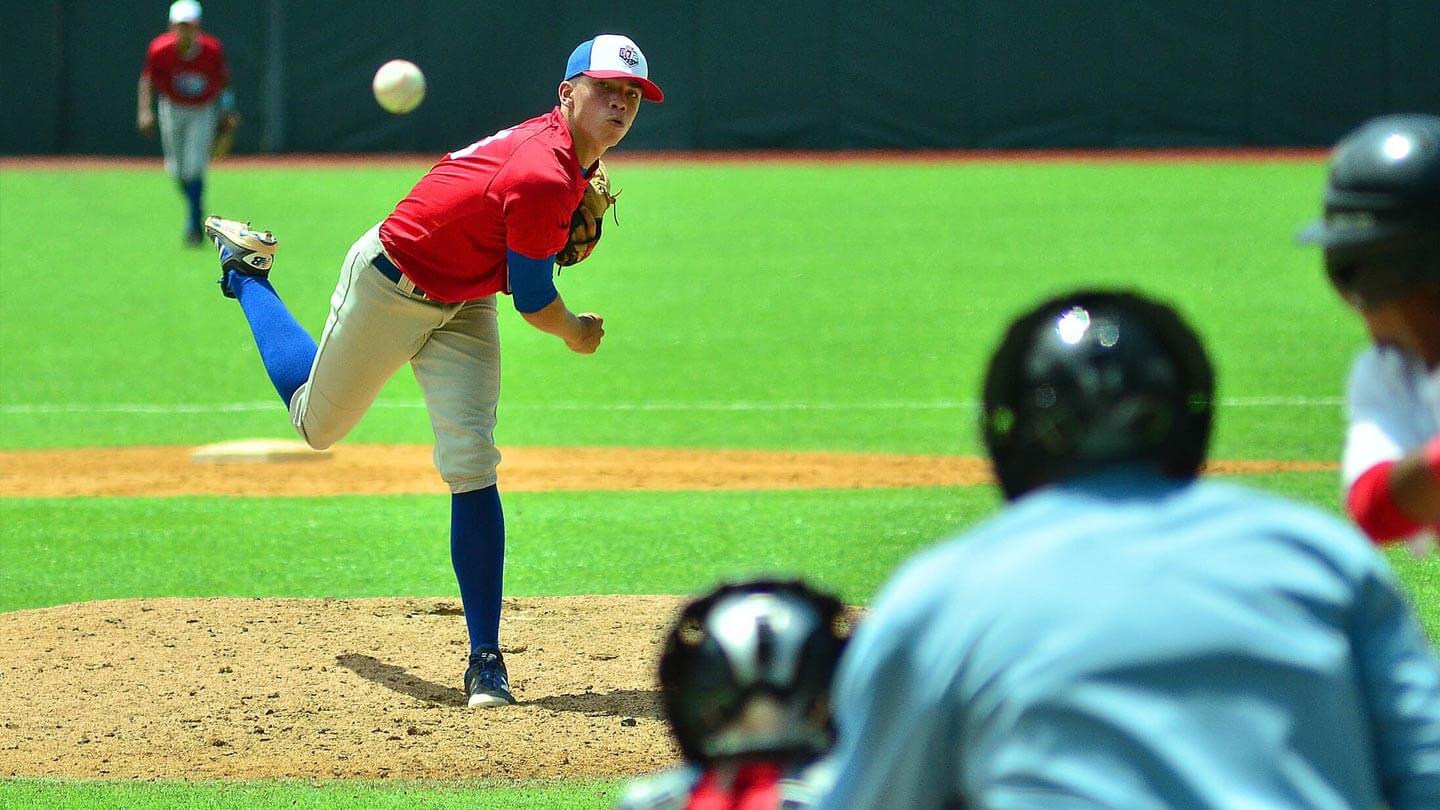
The long-term future of PR12 is bright, with both Alomar and MLB expressing interest in making it a yearly event. “We’re into projects that are lasting, not projects that you do it once and it’s great and people forget about it,” says Halem. “It’s our view that, in order to really make a lasting impact, you need to be focusing on projects and tournaments every year and over time you’ll see results.”
For his part, Alomar has designs on spreading the tournament throughout Latin America, in addition to continuing with the Canadian version. But that’s all for another day. Right now, he is focused on the task at hand, and by the time the first three games of PR12 are completed, he’s taken note of a few things. “I learned that there’s a lot of talent here in Puerto Rico,” he says. “I learned how happy these kids are when they talk to you. I learned they were looking for a tournament where they can tell that we care for them. That’s really important, that we care for the kids, we care for their effort and that we are here for them, to help them hopefully fulfill their dreams.”
The teenagers seem aware of that investment as they take a well-deserved seat beneath the Hiram Bithorn stands. The sun is setting on San Juan, the sky visible through the concourse’s lime-green fencing, and the 50 or so players enjoy a plate of chicken and bacon alfredo, with a bun on the side. Some guzzle down juice or chocolate milk, while others toast with soda. The nerves of the previous few days have washed away and they’re smiling. These boys have nothing to regret — Team Royal Blue and Navy Blue just played to a tightly contested 2-2 tie that featured strong defence and a few web gems that would make Alomar and Baerga proud.
Meanwhile, Alomar sits with a few of his coaches and a staff member in the manager’s office of the home clubhouse. The door is closed and he’s going over the day’s proceedings, likely working on how to make the next one better. There’s no meal for No. 12 just yet; he last ate about six hours ago. He’s too busy for food, of course. He’s got work to do.

